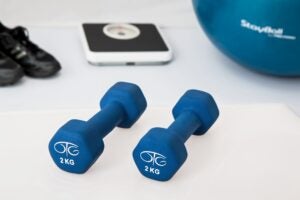
Research strongly supports the benefits of staying active across a range of physical and mental health conditions for people of all ages. In the U.S., the Department of Health and Human Services provides specific guidelines for physical activity at different stages of life. This page details some guidelines and considerations for pregnancy, older adults, and those exercising with chronic conditions. However, if you are new to exercise or have a specific medical condition, be sure to let your doctor know what type of exercise you’ll be starting. They can review the format to ensure it is safe with a specific health condition.
Pregnancy

Pregnancy is often associated with the discomforts of tiredness, nausea, or aches and pains from carrying extra weight at the belly. Though one may not feel like exercising, extra movement can actually help. It can increase strength and boost energy levels, and lower the risk of constipation and lower back pain—common issues during the latter trimesters. Exercise may also promote a healthier pregnancy. The Physical Activity Guidelines for Americans encourages moderate-intensity physical activity in healthy women during pregnancy to increase or maintain cardiovascular fitness, lower the risk of excess weight gain and development of gestational diabetes, and reduce symptoms of postpartum depression. [1] Preventing excess weight gain during pregnancy also lowers the risk of developing obesity after the delivery and conceiving an infant of higher birth weight (which increases the risk of a more difficult labor and health problems in the infant).
Risks
Possible risks of exercising during pregnancy include exercise-induced overheating of the body (which can harm the fetus) and risk of injures, especially falling or contact injuries. Exercising during this time may also raise concerns for a preterm delivery, low birth weight, or miscarriage. However, research shows a low risk of these complications with moderate-intensity exercise performed by healthy pregnant women. Exercise can reduce the risk of pregnancy complications such as preeclampsia (condition causing high blood pressure and protein spilling into the urine) and shorten the duration of labor and postpartum recovery time of the mother.
There are few exercise restrictions for healthy pregnant women under the close care of a healthcare provider. [2] One exception is that women in their second and third trimesters of pregnancy should avoid exercises that require lying on their backs, as this can potentially restrict blood flow to the fetus. They may also wish to avoid activities that risk collisions or excess force such as team sports, kickboxing, or diving, or that carries the risk of injury from falling, such as mountain climbing, downhill skiing, or horseback riding. Formats that can cause strained breathing like hiking in high elevations or doing Bikram yoga in high heat of 100 F temperatures can also be risky.
Pregnant women who have at-risk conditions such as heart disease, high blood pressure, certain lung diseases, cervical weakness, being pregnant with twins (or more), severe anemia, or preterm labor may be advised to not exercise or restrict the amount of exercise.
Recommended guidelines
- Unless there are medical reasons to not exercise during pregnancy, healthy women may engage in at least 150 minutes a week of moderate-intensity aerobic activity, preferably spread out through the week (e.g., 30 minutes 5 days a week rather than one or more hours over 2 consecutive days). [1]
- If a woman exercises for the first time during pregnancy, it is recommend to start slowly and increase the time and intensity gradually. [3]
- Because the heart pumps out more blood during pregnancy, the heart rate is naturally higher. Therefore, measuring heart rate during exercise may not be useful to gauge intensity. Instead, the talk test can be used: if one achieves a moderate-intensity level, she should be able to talk to someone nearby but not be able to sing. If she achieves a vigorous-intensity level, she may feel more breathless and would not be able to say more than a few words.
- Pregnant women who regularly participated in vigorous aerobic exercise and or strength training prior to pregnancy can continue to do so throughout the pregnancy and postpartum. However, with natural pregnancy weight gain, it is emphasized to listen to one’s body and slow down or modify movements as needed.
- During the 2nd and 3rd trimesters, it is easy for the body to overheat during exercise, thereby increasing the risk of the fetus overheating. Bring a water bottle and take sips every 15 minutes. Continually gauge intensity level during the exercise session using the talk test. If feeling lightheaded or dizzy at any point, take a quick break or slow down the intensity.
- Stop exercising and contact your physician if you experience any of the following: blood or fluids leaking from the vagina, uterine contractions, shortness of breath that doesn’t stop when you end the exercise, swelling in the legs, or chest pain.
- Pregnant women should consult with their healthcare provider if they need to adjust their exercise during the progression of the pregnancy, as well as after the baby is born.
Older Adults

Adults ages 65 and older can reap many health benefits from a consistent physical activity regimen. These benefits have also been observed in those with chronic conditions like osteoarthritis and cardiovascular disease. [4] In addition, exercise can help improve balance and strength that make daily activities easier to perform (lifting groceries, doing laundry, raking leaves, getting out of bed or a chair, climbing stairs, and standing for long stretches while cooking). However, more than a third of this age group report not getting any regular exercise, and only about 16% meet the national guidelines of getting at least 150 minutes of moderate-intensity aerobic activity or 75 minutes of vigorous-intensity aerobic activity and two or more days of muscle-strengthening activities each week. [4]
A large cohort study of more than 99,700 adults ages 60 years and older found that those who met weekly guidelines for moderate to vigorous aerobic physical activity combined with weightlifting (such as using free weights or resistance machines 1-2 days a week) had a 41% lower risk of death than those who did neither. [5] Those who engaged in both exercise types also had a lower risk of death compared with those who performed just aerobics or just weightlifting. Consistent weightlifting is associated with increased lean muscle mass and strength, which can combat sarcopenia, a progressive loss of muscle and strength that naturally occurs with aging beginning in mid-life.
An exercise prescription for older adults should consider their health status and functional ability. Yet any amount of exercise is better than being sedentary, even if one cannot achieve the recommended goals. Time spent sitting tends to increase with age, and this is associated with elevated blood sugar and risk of early death. [4] The following are important considerations to discuss with a healthcare provider when deciding upon an exercise regimen.
- Identifying barriers to exercise and reviewing potential solutions.
- Discussing specific recommendations on the type (exercise format), frequency (how many times a week), duration (for how long), and intensity of activities (using a measure such as the talk test).
- Setting achievable short-term and long-term activity goals based on one’s preferences and abilities.
Types of exercise
Older adults benefit from the following formats: aerobic, strength or resistance training, flexibility or stretching, and balance training. Aerobic exercise, also referred to as cardiovascular or endurance exercise, moves the legs and arms in a rhythmic tempo. Examples are brisk walking, bicycling, water aerobics, tennis, or dancing, all of which make the heart beat faster and become stronger over time. Balance and flexibility training such as tai chi or yoga can help reduce falls. Resistance training with weight machines, exercise bands, hand-held weights, or doing push-ups and squats helps to slow down and even reverse the normal progression of losing muscle strength with age. There are various resources and options available when starting to exercise:
- Local YMCAs and community senior centers offer classes specifically geared toward older adults. More gyms and fitness studios also have classes for older adults, as the American College of Sports Medicine cites this age group to be a top target for fitness according to their annual worldwide survey of fitness trends. [6]
- If a person is very deconditioned, frail, or recovering from injuries, working with a physical therapist may be helpful. This offers personalized attention in creating a safe and progressive exercise regimen. Some insurances cover these visits if referred by a physician.
- Those who are new to exercise but not severely deconditioned may choose to work with a personal fitness trainer who is experienced working with older age groups and certified by an accredited organization such as the American Council on Exercise or American College of Sports Medicine.
Barriers
Barriers to exercise include a lack of knowledge, lack of motivation, and poor health. Factors that may prevent or reduce the ability to exercise include chronic medical conditions, medications, poor nutrition status, and injuries. Guidance by a physician and a certified exercise professional can help reduce these risks and provide a safe exercise regimen within one’s abilities. The format and intensity will vary, but most people regardless of their condition can do some level of physical activity. Being sedentary and inactive greatly increases the risk of worsening health problems or developing new chronic conditions.
Recommended guidelines
- Aim for at least 150 minutes of moderate-intensity aerobic exercise and two or more days of resistance training a week. Even if this cannot be achieved at first, accomplish what is possible, as some physical activity is always better than none.
- An exercise regimen may be unstructured, such as climbing stairs in the house several times a day or walking to do errands, or structured such as participating in an exercise program with planned repetitive movements to increase physical fitness.
- If one has chronic medical conditions or is functionally limited, the intensity and duration of the exercise should begin at a lower level.
- For frail or very deconditioned individuals, muscle strengthening exercises and balance training are recommended before starting aerobic exercises. Ideally balance training should be performed three or more days a week. Regular physical activity can improve the ability to walk independently, balance to reduce falls, strength, and quality of life.
Exercising with Chronic Conditions

Here are some general considerations for those looking to engage in physical activities with chronic medical conditions. However, individuals should discuss with their doctor how their condition may affect their ability to perform regular exercise.
Osteoarthritis or musculoskeletal pain
Joint pain in the hips, knees, or lower back may limit exercise ability and even cause hesitation in exercising for fear of worsening the pain. Starting an exercise program in the water such as a heated pool helps to reduce the amount of body weight or pressure placed on the joints, which can lessen pain. This can help build endurance and strength; however it is recommended to also include out-of-water exercises when possible, as they may provide greater aerobic benefits and improvements in pain than water exercises alone. Research shows that when performed safely, low-impact aerobic and strengthening exercises help those with osteoarthritis to have less pain and greater physical function, quality of life, and mental health. [7] Walking, tai chi, and gentle yoga are other exercises that are recommended with joint pain.
Osteoporosis
Research most supports resistance or strength exercises to increase bone density in men and women. [4] High-impact aerobic exercise may also help to increase bone mass but carries a higher risk of injury. Incorporating balance training can help to prevent falls. Activities that do not bear much weight such as swimming and walking are not as effective at improving bone density. Those with severe osteoporosis and prior fractures are at risk for additional fractures and should receive close guidance by their physicians or a physical therapist to avoid further injuries.
Physical disabilities
A disability can occur as a result of a medical condition (stroke), a trauma or accident (spinal cord or brain injuries), or an inherited condition (cerebral palsy, muscular dystrophy). Regular physical activity that accounts for one’s abilities and functional limitations is recommended because it can help improve quality of life and reduce the risk of worsening a disability or developing new medical conditions arising from inactivity. If able, exercise should include 150-300 minutes (5 hours) a week of moderate-intensity movements, preferably spread out throughout the week. [1] Muscle-strengthening activities of moderate or greater intensity that involve all major muscle groups on two or more days a week can provide additional health benefits.
Cardiovascular disease
Exercise makes heart muscle stronger, can lower blood pressure and cholesterol, and controls body weight. If one has a preexisting heart condition such as a heart attack or heart surgery or experience chest pain, a stress test may be recommended before beginning a vigorous exercise routine. However, a moderate exercise routine is safe for most people, which might include brisk walking or bicycling for a minimum of 150 minutes of aerobic exercise, spread over three to five days of the week, and strength training twice a week. If feeling chest pain/pressure, irregular heartbeat, numbness in the arm, or shortness of breath, stop the exercise and rest. If the symptoms continue after stopping the exercise, consult your physician.
Type 2 diabetes
Exercise protects against heart disease, which is a leading cause of death in people with type 2 diabetes. It also reduces body weight, blood pressure, and blood glucose, which can reduce complications occurring from poorly controlled diabetes. At least 150 minutes of moderate-intensity aerobic activity a week, and muscle strengthening exercises twice a week is recommended. Both types of exercise help the body’s insulin to work more efficiently to lower levels of glucose in the blood, even without weight loss. [8] It is important for people with diabetes to monitor their blood glucose before and after exercise, and to engage in regular foot care. Diabetic neuropathy in the feet damages nerves and causes loss of feeling, so if one does not notice and attend to an injury like a cut or sore, it could lead to infection.
Related
Last reviewed December 2022
Terms of Use
The contents of this website are for educational purposes and are not intended to offer personal medical advice. You should seek the advice of your physician or other qualified health provider with any questions you may have regarding a medical condition. Never disregard professional medical advice or delay in seeking it because of something you have read on this website. The Nutrition Source does not recommend or endorse any products.

